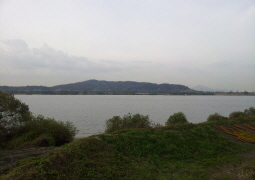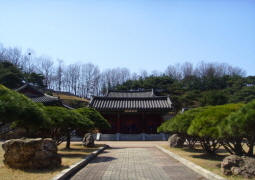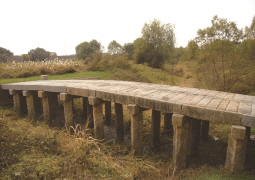
Path in the old hometown, Hangjunaru
This is the ferry where boatman rows on the ship and takes passengers across the river with wooden ship when they are called from the other side of the river. This is a reminiscent story, right? When there was no bridge in Han River, there were people going across the river to shop, housewives going to their home, and those who were about to enjoy boating. Ferry is relevant to bus terminal today. This place was always crowded full of foods to eat and scenes to watch. As Hangju bridge was constructed in 1978, ferry no longer existed. However, there are still many restaurants in old style that people tend to come to enjoy traditional food.

Tomb of general Yuhyeong defeating Japanese soldiers with the general Sunshin Lee
Surrounded by four castles, the tomb of the general Yuhyeong is in the size of about 30py. There are stoneworks near burial mounds. There is an epitaph to the right side of burial mound. In front of the burial mound, there are Sangseokg and Hyangroseok, and there is Muninseok to the left and right side of the front area. There is a Sindobi next to the road below the tomb. There is a phrase, 贈領議政 輔祚功臣 晋山府院君 諡忠景 柳公神道碑銘, written on the Sindobi. Yuhyeong (1566-1615) is a soldier that achieved great accomplishments during Japanese invasion. His real name is Jaon, and other name is Seokdam. He helped the general Sunshin Lee conquer Japanese soldiers during the siege of Jungyu and became the Samdosu governor next to Sunshin Lee in 1602. His posthumous epithet is Chunggyung, and he is served in Minchungsa at Haenam. His tomb is located in the park across the tomb of Jinju Ryu at Muwon Village in Haengsin-dong.

Transportation path towards Seoul, Stone bridge in Gangmae-dong
There is Gangmae Station of Gyeongui Line to the end of the east at Haengshin district that was developed as a new city. To the south of Gangmae Station, there is a way to the direction of Bongdae Mountain. There is bank if you enter the lower area of Bongdae Mountain.
If you go about 50m along the un-paved road to the opposite direction of Hangju Fortress on top of this bank, there is a bridge. This is the stone bridge at Gangmae-dong. This has been a bridge used as a tranporttation path for people from the west to go to Seoul at Han River including Ilsan, Jido, and Songpog of Goyang in the past. The basic structure of the bridge is that the frame was built with 18 stone pillars with rectangle Gopanseoks on top of them. There are two rows of Gyopanseoks with 6-7 stones between the piers. As for overall image of the bridge, the bridge is connected from the South to the North. Due to the middle part that is higher than the both sides, it is in a shape of curve. According to [Goyang-gun Log] issued in 1755 on annals in Youngjo, it was called as Haepo bridge in the past. It was also known to be made with woods. Records as a stone bridge are that it was 江梅里橋 庚申新造 enscribed on the side of a bridge. This shows that the bridge was constructed in the 1920s. Stone bridge in Gangmae-dong is accessible through Soman village in Haengshin-dong and Ganggosan village at Gangmae-dong. Bridge is well preserved with original shape in the Joseon Dynasty. Seeing as how it is the one and only traditional bridge, it is valuable as cultural asset.


